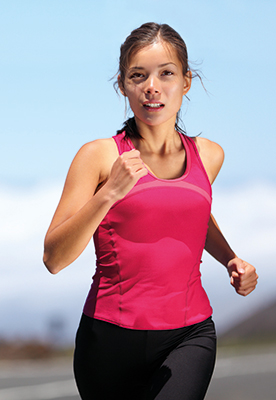
Rude Fit
Run for your life
The Dublin Marathon will see thousands of people running for charity on Monday October 27th. Rude Health magazine looks at how best to prepare for a marathon or other run.
"Anyone can do it as long as you give yourself enough time to prepare and set a realistic goal for yourself”, says Carl Cautley, owner of Ranelagh personal training studio Fitness Together. “However, if you have an injury, health or medical condition, get medical advice before starting.”
“A marathon is an achievable goal for most people once you take the time to put in sufficient preparation in advance,” says Jim Aughney, Race Director, SSE Airtricity Dublin Marathon.
What kit to buy
“Number one, buy a proper pair of running shoes,” says Carl Cautley. “Shoes that are designed for running, not fashion. They must have good arch support and a sole that will absorb impact. There are a number of stores that will do a gait analysis. Buy gear you are comfortable training in, doesn’t really matter what, as long as you are comfortable.”
“A good pair of shoes is the top priority, go to a sports shop and see what type of shoe best suits your running style,” says Jim Aughney. “In warm weather use clima-cool tops rather than cotton tops as they are much better for moisture management.
Hydration
“If you’re thirsty, you’re already dehydrated,” says Dr Jay Pennock, doctor of emergency medicine and medical advisor to multivitamin supplement Oxylent. “Other signs include dry lips, tongue or eyes, headache and fatigue. Dehydration causes your heart to work harder and your blood to thicken. Left untreated, dehydration can ultimately lead to heat stroke, which requires medical treatment. The best thing you can do is to stay properly hydrated to avoid dehydration in the first place.”
According to Carl Cautley: “If you are doing short distances hydration isn’t a big problem, just make sure you drink plenty of water during the day. If it is a half marathon or full marathon you will need a proper hydration/nutrition plan.”
“For shorter runs, a simple bottle of water should do the trick,” says Jim Aughney. If you’re running for more than an hour, or in particularly hot or humid weather, consider switching to sports drinks which contain carbohydrates for energy and electrolytes to bolster hydration.”
Nutrition
“To keep your body full of energy during long runs, mix up the types of carbs you ingest,” says Jim Aughney. “A mix of glucose, fructose and sucrose will improve the rate of carbohydrate absorption and help you feel the effects faster. I recommend handfuls of nuts or raisins, and specially formulated gels that are easy to transport in pockets. For better recovery after long runs, try to eat a small snack immediately after you finish running. The other half of your pre-run bagel or a handful of almonds should do the trick.”
“Athletes are often encouraged to consume sugary energy products in order to maximise energy and insulin levels and fuel their run,” says Dr Jay Pennock. “But research now shows that sugars are not the best way to sustain energy and maximise performance, endurance and recovery. In fact, instead of providing healthy energy, sugar can actually lead to increased muscle fatigue, decreased performance, and slower recovery.
“Rather than sugars and highglycemic carbohydrates, consuming low-glycemic carbohydrates along with good protein and fat is a better way to nourish the body with the fuel it needs. This causes a slow and steady increase in glucose levels and a modest increase in insulin.”
Training tips
According to Carl Cautley, “if you are a beginner, you need to do a combination of walking and running. As you get fitter the run will get longer and more intense. Mix up where you do your training, i.e. treadmill, road, grass and hard sandy beach. Find an event you would like to do, give yourself at least three months and get started today.”
“If you are tackling the marathon for the first time you need to build up the mileage gradually each week, doing about 10% more each week,” says Jim Aughney. “Marathon training is a big commitment. You can expect to spend 10 hours a week in training, possibly more. A training schedule may have three runs per week - one easy run, one tempo (faster) run and one long run per week. On two to three of your non-running days, you should do some cross training, such as biking, swimming or strength training. Remember to always leave at least one or two rest days in your schedule.”
On the day
“When the starting gun cracks on race day morning and the runners around you surge forward, remember above all else to pace yourself,” says Jim Aughney. “Those guys breaking free from the pack at mile two may be on their knees by mile 24. Imagine yourself waving merrily as you pass them by. On race day, all you have to do is trust your training and not let all the excitement get the better of you. There will be plenty of cause for celebration at the finish line.”
For more information on the Dublin marathon see www.dublinmarathon.ie
Exercise of the issue:
The burpee
One of the best all-round exercises, the burpee works so many different body parts: calves, quads, hamstrings, lower back and arms as well as developing your cardiovascular system. Stand upright with your arms at your sides. Bend over and squat down. Place hands on floor, slightly wider than shoulder width. While holding upper body in place, kick legs back. Land on forefeet with body in straight, plank position. Keeping upper body in place, pull legs forward under body returning feet to original position. Jump into air, land with bended knees and go again. Three sets of 10 repetitions and you have a great workout.
Click here to read other Rude Fit articles.
Click here to return to the Rude Health Magazine homepage.